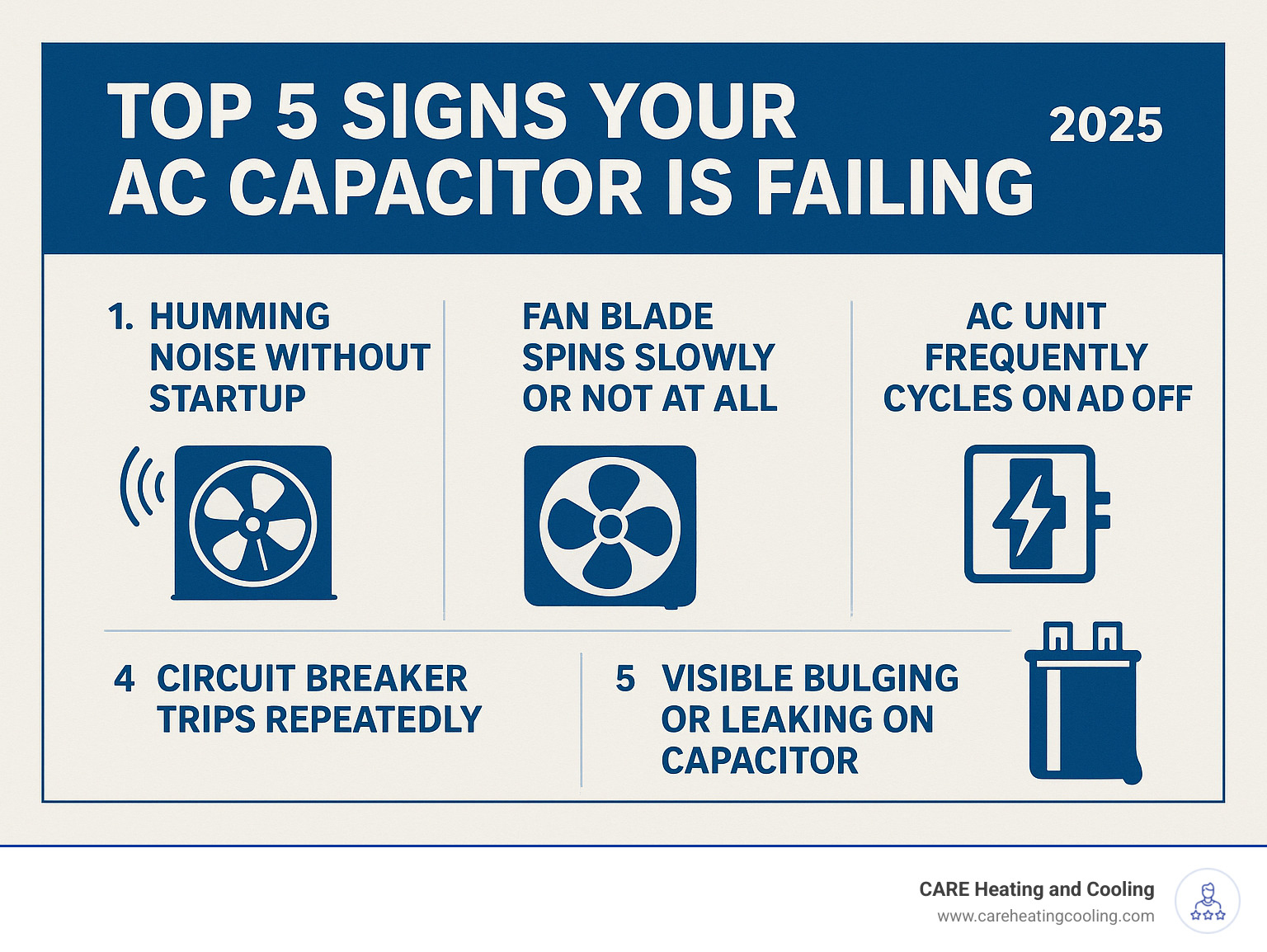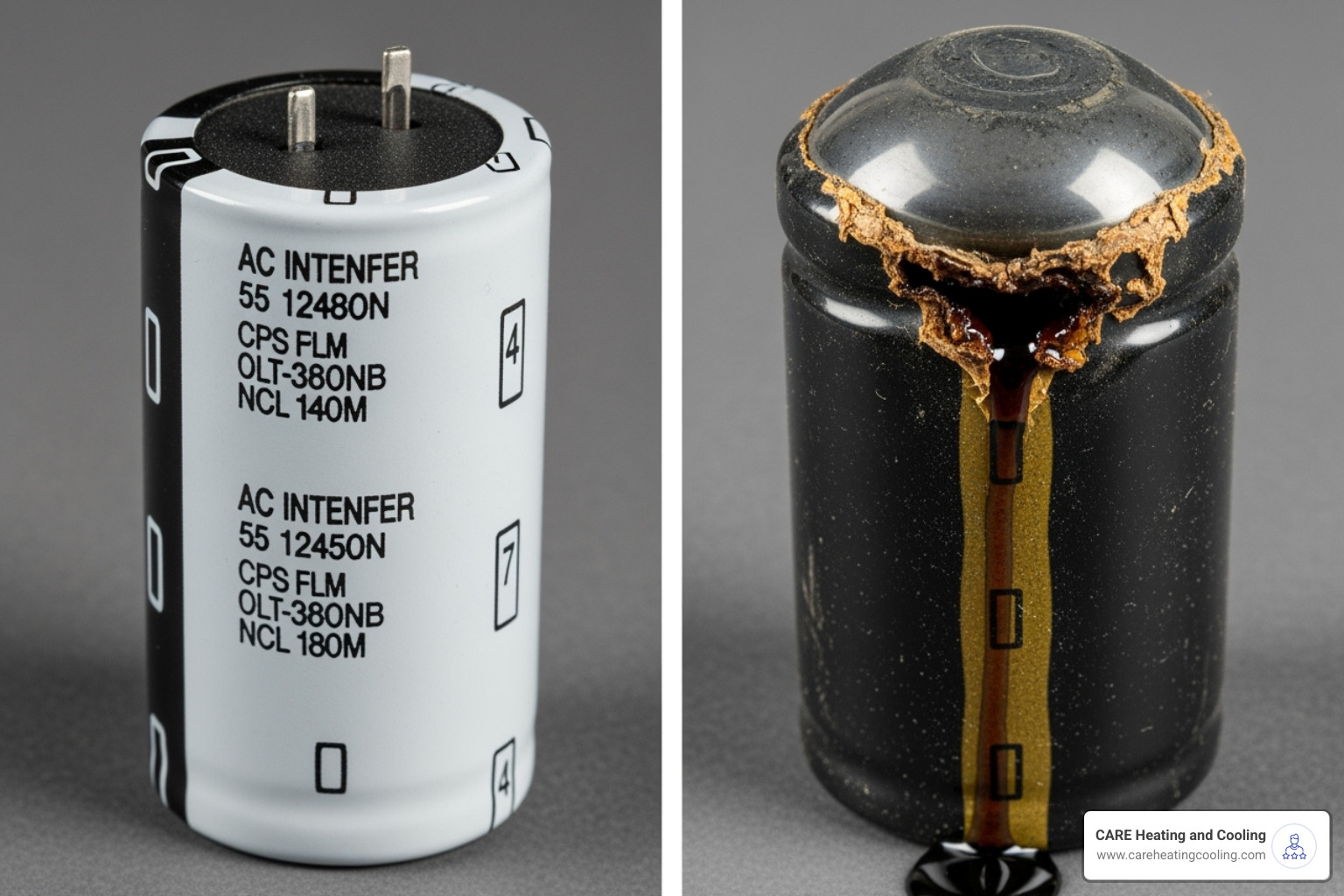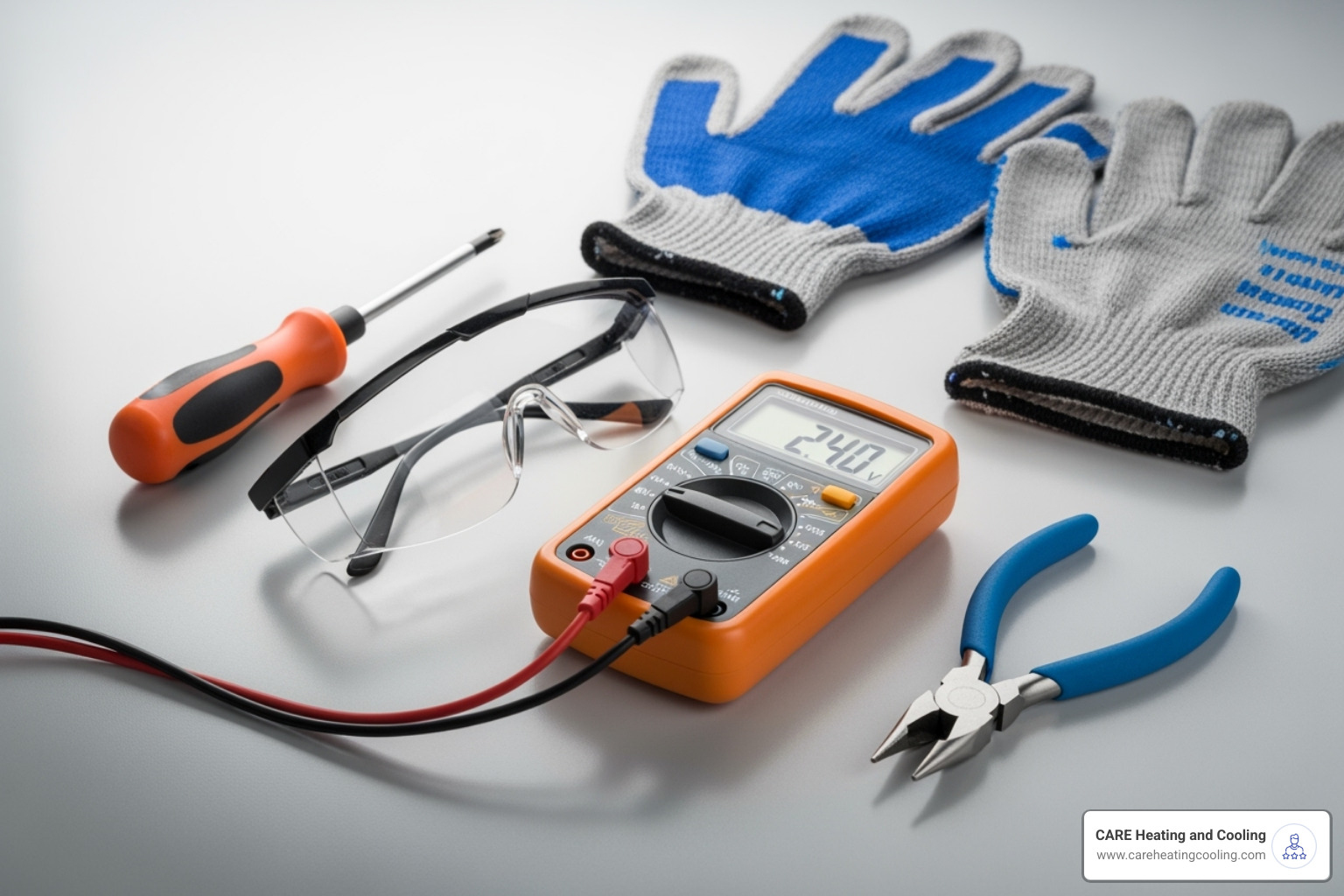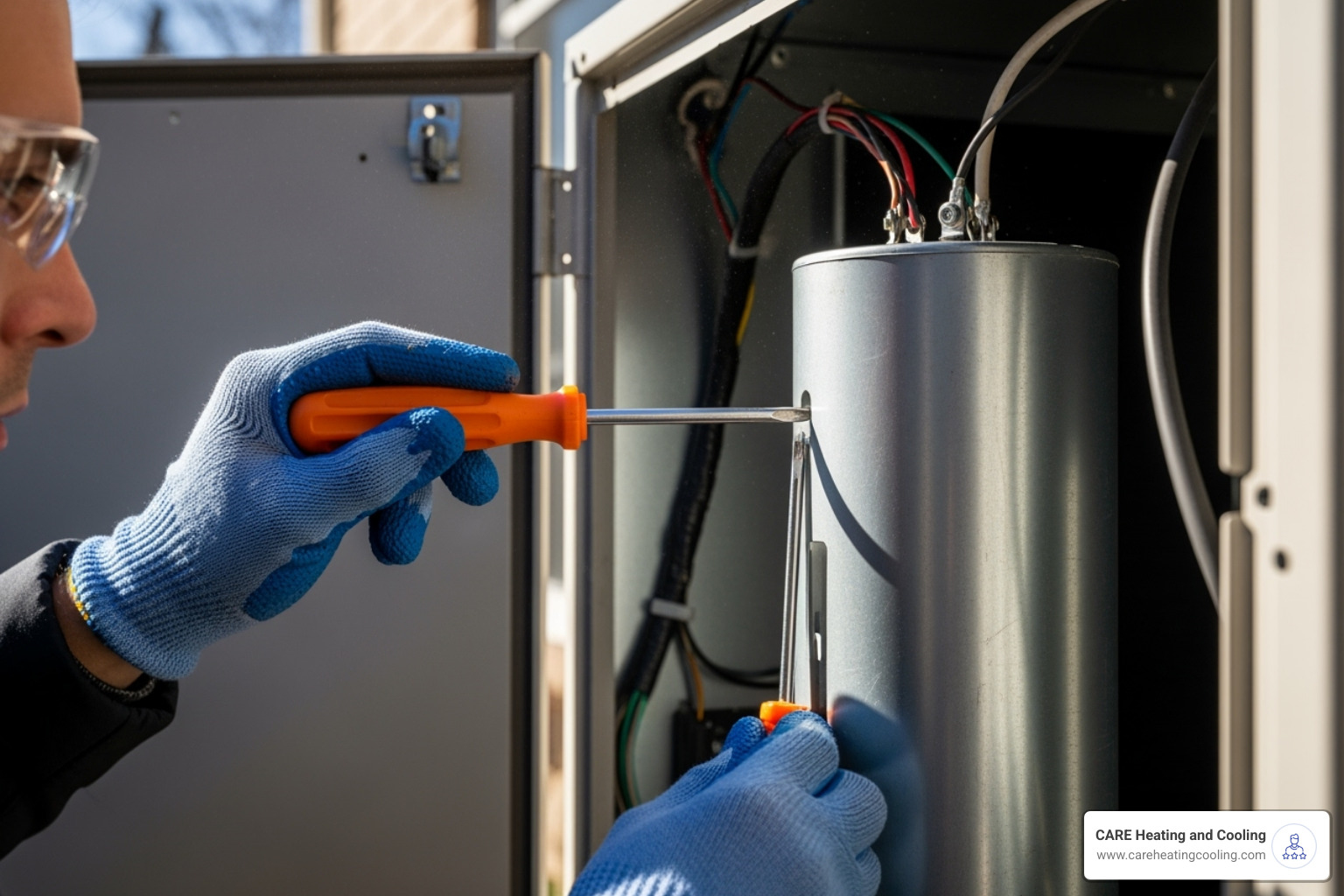When Your AC Starts Humming But Won’t Cool
AC capacitor replacement is a common repair for an air conditioner that makes strange noises but fails to cool. If you hear a loud hum but the fan isn’t spinning, a failing AC capacitor is the likely culprit. This small but critical component provides the electrical jolt needed to start your system’s motors.
Quick Answer for AC Capacitor Replacement:
- Cost: $100-$400 (including parts and labor)
- Time: 1-2 hours for professional replacement
- Safety: High-voltage component – professional replacement is strongly recommended
- Lifespan: Most capacitors last 10-20 years
- Key Signs: Humming sounds, slow fan startup, frequent cycling
Your AC’s capacitor, compressor (pressurizes refrigerant), and fan motor (moves air) must work together. When the capacitor fails, it can’t provide the necessary boost, which strains the other expensive components. Catching this problem early can save you from a costly compressor replacement.
However, capacitor replacement involves high-voltage electricity that can cause serious injury or death, even when the power is off. This guide will help you identify capacitor problems and understand why calling a professional is the safest choice.
Understanding Your AC’s Key Components and Spotting Trouble
An AC capacitor stores and releases electrical energy in a quick burst to help your system’s motors start. Without this initial jolt, the motors can’t overcome their natural resistance to get spinning.
Air conditioners use a few types of capacitors. A start capacitor provides the initial jolt, while a run capacitor provides steady energy to keep the motors running smoothly. Many modern units use a dual-run capacitor, a single component that serves both the compressor motor (the heart of your system) and the fan motor.
When a capacitor fails, you may notice reduced cooling or a system that won’t start at all. These issues can overlap with other problems, so it’s helpful to understand all the Signs You Need AC Repair or why your AC is Blowing Hot Air.
Signs of a Failing AC Capacitor
Catching a failing capacitor early can prevent a much more expensive compressor replacement. The easiest way to check is to look for physical damage on the capacitor itself.
- Bulging or Swelling: The most obvious sign is a capacitor that looks swollen or puffy.
- Leaking: Look for dark, oily residue around the terminals, indicating an internal fluid leak.
- Humming or Clicking Noises: A loud hum without the fan starting is a classic symptom. Clicking can mean the system is trying but failing to start. Learn more about why your AC Makes Clicking Noises.
- Fan Issues: The outdoor fan may spin slowly, struggle to start, or not move at all.
- Electrical Problems: The AC may trip the circuit breaker repeatedly or shut down intermittently.
- Increased Energy Bills: A struggling motor draws more power, leading to higher utility costs.
If you notice several of these signs, your capacitor likely needs attention.
How a Bad Capacitor Affects the Compressor and Fan
Ignoring a failing capacitor gets expensive fast. Without the necessary starting energy, your compressor and fan motors struggle, drawing more power and generating excess heat. This overheating is one of the quickest ways to destroy expensive AC components.
The compressor takes the biggest hit. It attempts to “hard start” repeatedly, putting immense stress on its internal parts. This can lead to complete compressor failure, turning a simple AC capacitor replacement into a repair that could cost thousands.
Even if the motors start, they run inefficiently with a weak capacitor, increasing your energy bills while providing less cooling. In the worst case, a dead capacitor means total system failure. Understanding what is a capacitor helps clarify why this small part has such a large impact. Acting quickly is the smartest investment you can make in your AC’s health.
Your Step-by-Step Guide to AC Capacitor Replacement
When your AC fails on a hot day, fixing it yourself is tempting. While we’ll walk through how AC capacitor replacement works, we must be clear: this information is for educational purposes only.
Capacitors store dangerous amounts of electricity, even when the AC is off. An electrical shock can cause severe injury or death. Unless you are experienced with high-voltage electrical work and have the proper safety gear, we strongly recommend calling a professional. Your safety is worth more than the cost of a service call. For urgent issues, see our Emergency AC Solutions.
Essential Safety Precautions and Tools
Safety is paramount when dealing with the high voltage in an AC unit. Professional technicians use specific tools for a reason.
Key tools include safety glasses, insulated work gloves, a multimeter with a capacitance function, insulated screwdrivers, and needle-nose pliers. You’ll also need the correct replacement capacitor and a smartphone to take photos of the wiring before you begin.
Turning off the power is non-negotiable.
- Turn the thermostat to “Off.”
- Switch off the AC’s breaker in your home’s main electrical panel.
- Turn off the power at the outdoor disconnect box, usually located on the wall near the unit.
- Use a multimeter to verify zero voltage at the unit’s power terminals before proceeding.
Locating, Discharging, and Testing the Capacitor
With the power confirmed off and safety gear on, a technician would remove the AC unit’s access panel to find the capacitor—a component shaped like a metal can.
Before touching anything, it’s crucial to take a photo of the wire connections. This prevents guesswork and wiring mistakes later.
Next is the most critical safety step: discharging the capacitor. Even with the power off, it holds a dangerous electrical charge.
A technician uses an insulated screwdriver to bridge the capacitor’s terminals, safely releasing the stored energy. You can find more details on how to safely discharge a capacitor, but this step is best left to a trained professional.
Finally, the capacitor is tested with a multimeter. The multimeter is set to measure capacitance (µF or MFD), and the reading is compared to the specifications printed on the capacitor’s label. A reading that is significantly low or zero confirms the capacitor has failed.
Choosing and Installing the New Capacitor
Selecting the correct replacement capacitor is vital. The new part must match the old one’s specifications to avoid damaging your AC system.
- Microfarad (µF/MFD) Rating: This must match exactly. For a dual capacitor (e.g., 45/5 µF), both numbers must match.
- Voltage Rating: You can use a replacement with an equal or higher voltage rating (e.g., replacing a 370V with a 440V is fine), but never use one with a lower rating.
- Physical Shape and Terminals: The shape (round or oval) should fit the mounting bracket, and the terminals must match.
Installation involves disconnecting the wires (referencing the photo), removing the old capacitor, securing the new one in the bracket, and reconnecting the wires to the correct terminals (C, HERM, FAN). A secure connection is essential.
After reinstalling the access panel, power is restored in the reverse order it was turned off: disconnect box first, then the circuit breaker, and finally the thermostat. A professional then tests the system to ensure the fan and compressor start smoothly and cold air is flowing.
Cost, Lifespan, and Professional vs. DIY Repair
Understanding the costs and lifespan of an AC capacitor can help you make smart decisions. Most capacitors last 10 to 20 years, but several factors can shorten this lifespan.
- Heat: Constant exposure to high temperatures during brutal Ohio summers takes a toll on internal components.
- Heavy Usage: Systems that cycle frequently or run for long hours put more wear on the capacitor.
- Power Surges: Electrical fluctuations from storms or the power grid can damage the capacitor.
- Poor Ventilation: Debris or overgrown plants around the outdoor unit trap heat, forcing the system to work harder.
Regular maintenance, like our AC Tune-Up Services, includes inspecting electrical components and can catch a weakening capacitor before it fails completely.
Understanding the Cost of AC Capacitor Replacement
Fortunately, AC capacitor replacement is one of the more affordable AC repairs. The part itself is inexpensive, typically costing between $8 and $45. The main cost difference is between DIY and professional service.
Professional installation includes the technician’s labor, expertise, diagnostic tools, and safety protocols. Expect to pay for labor (often $75-$150 per hour) and a service or diagnostic fee. The total professional cost typically ranges from $100 to $400. Prices can be influenced by your location, the time of year, and whether it’s an emergency call. Compared to a compressor replacement, which can cost thousands, this is a minor repair.
DIY vs. Professional AC Capacitor Replacement: Making the Safe Choice
While the cost savings of a DIY repair are tempting, the risks are significant. We need to be direct about the dangers.
- Electrical Shock Hazard: Capacitors store 370 to 440 volts, even when the power is off. This is more than enough to cause serious injury or death. This is not a risk worth taking.
- Further System Damage: Installing the wrong part or miswiring the connections can destroy your compressor, turning a small repair into a catastrophic failure.
- Warranty Issues: Many manufacturers require repairs by licensed professionals to keep your warranty valid. A DIY repair could void your coverage.
Choosing a professional for your AC capacitor replacement offers clear advantages:
- Safety: Technicians are trained to handle high-voltage components safely.
- Proper Diagnosis: A pro can determine if the capacitor is the true cause of the problem or just a symptom of a larger issue.
- Expertise and Efficiency: The job is done quickly and correctly, with the right parts.
- Peace of Mind: Reputable companies guarantee their parts and labor.
For reliable AC Repair in Westerville and central Ohio, professional service is a smart investment in your safety and comfort.
Frequently Asked Questions about AC Capacitors
We’ve answered thousands of questions about AC capacitors over the years. Here are the most common ones.
Can a bad capacitor ruin an AC compressor?
Yes, absolutely. A failing capacitor forces the compressor to struggle and overheat during startup. This repeated strain, known as “hard starting,” can quickly burn out the compressor motor, turning a simple AC capacitor replacement into a repair costing thousands. Prompt replacement is critical to protect your compressor.
How long does an AC capacitor typically last?
In Ohio, an AC capacitor generally lasts 10 to 20 years. However, factors like extreme summer heat, frequent power surges, and poor airflow around the outdoor unit can cause it to fail sooner. Regular maintenance helps identify a weakening capacitor before it leaves you without cooling.
Can I use a capacitor with a higher voltage rating?
Yes, this is a common question. You can safely use a capacitor with a higher voltage rating, but you must never use one with a lower rating. The key is that the microfarad (µF) rating must match your original capacitor exactly. The voltage rating is a maximum limit; a higher rating provides a larger safety margin against power spikes, while a lower rating will cause the part to fail quickly.
Stay Cool with Expert, Trustworthy AC Repair
When your AC hums but won’t cool, it’s time for action. We’ve explained how AC capacitor replacement works, but understanding the process highlights the risks involved. Working with high-voltage components is serious business, and a DIY mistake can lead to injury, a damaged system, or a voided warranty.
At CARE Heating and Cooling, we’re straight with you. We earned the BBB Torch Award for Ethics because we’re committed to doing what’s right for our customers. Our unique philosophy is that our technicians are paid to fix your unit, not to sell you a new one. This ensures we recommend only what you truly need.
Our repair-first approach means we explore every option to get your system running efficiently. Sometimes it’s a simple capacitor swap; other times, our experienced technicians find an underlying issue that others might miss.
Don’t let a failing capacitor turn your home into a sauna. For any cooling crisis in the Columbus area, we’re here to help get your system running safely and efficiently.
Ready to get your AC humming the right tune again? Schedule Your Heating or Cooling Repair in Columbus today and experience the peace of mind that comes with truly ethical, expert service.










